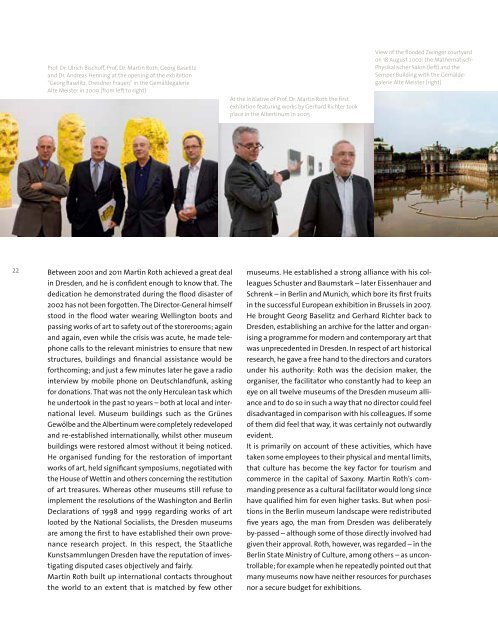2011 - Staatliche Kunstsammlungen Dresden
2011 - Staatliche Kunstsammlungen Dresden
2011 - Staatliche Kunstsammlungen Dresden
You also want an ePaper? Increase the reach of your titles
YUMPU automatically turns print PDFs into web optimized ePapers that Google loves.
22<br />
Prof. Dr. Ulrich Bischoff, Prof. Dr. Martin Roth, Georg Baselitz<br />
and Dr. Andreas Henning at the opening of the exhibition<br />
“Georg Baselitz. Dresdner Frauen” in the Gemäldegalerie<br />
Alte Meister in 2009 (from left to right)<br />
Between 2001 and <strong>2011</strong> Martin Roth achieved a great deal<br />
in <strong>Dresden</strong>, and he is confident enough to know that. The<br />
dedication he demonstrated during the flood disaster of<br />
2002 has not been forgotten. The Director-General himself<br />
stood in the flood water wearing Wellington boots and<br />
passing works of art to safety out of the storerooms; again<br />
and again, even while the crisis was acute, he made telephone<br />
calls to the relevant ministries to ensure that new<br />
structures, buildings and financial assistance would be<br />
forthcoming; and just a few minutes later he gave a radio<br />
interview by mobile phone on Deutschlandfunk, asking<br />
for donations. That was not the only Herculean task which<br />
he undertook in the past 10 years – both at local and international<br />
level. Museum buildings such as the Grünes<br />
Gewölbe and the Albertinum were completely redeveloped<br />
and re-established internationally, whilst other museum<br />
buildings were restored almost without it being noticed.<br />
He organised funding for the restoration of important<br />
works of art, held significant symposiums, negotiated with<br />
the House of Wettin and others concerning the restitution<br />
of art treasures. Whereas other museums still refuse to<br />
implement the resolutions of the Washington and Berlin<br />
Declarations of 1998 and 1999 regarding works of art<br />
looted by the National Socialists, the <strong>Dresden</strong> museums<br />
are among the first to have established their own provenance<br />
research project. In this respect, the <strong>Staatliche</strong><br />
<strong>Kunstsammlungen</strong> <strong>Dresden</strong> have the reputation of investigating<br />
disputed cases objectively and fairly.<br />
Martin Roth built up international contacts throughout<br />
the world to an extent that is matched by few other<br />
At the initiative of Prof. Dr. Martin Roth the first<br />
exhibition featuring works by Gerhard Richter took<br />
place in the Albertinum in 2005<br />
View of the flooded Zwinger courtyard<br />
on 18 August 2002: the Mathematisch-<br />
Physikalischer Salon (left) and the<br />
Semper Building with the Gemäldegalerie<br />
Alte Meister (right)<br />
museums. He established a strong alliance with his colleagues<br />
Schuster and Baumstark – later Eissenhauer and<br />
Schrenk – in Berlin and Munich, which bore its first fruits<br />
in the successful European exhibition in Brussels in 2007.<br />
He brought Georg Baselitz and Gerhard Richter back to<br />
<strong>Dresden</strong>, establishing an archive for the latter and organising<br />
a programme for modern and contemporary art that<br />
was unprecedented in <strong>Dresden</strong>. In respect of art historical<br />
research, he gave a free hand to the directors and curators<br />
under his authority: Roth was the decision maker, the<br />
organiser, the facilitator who constantly had to keep an<br />
eye on all twelve museums of the <strong>Dresden</strong> museum alliance<br />
and to do so in such a way that no director could feel<br />
disadvantaged in comparison with his colleagues. If some<br />
of them did feel that way, it was certainly not outwardly<br />
evident.<br />
It is primarily on account of these activities, which have<br />
taken some employees to their physical and mental limits,<br />
that culture has become the key factor for tourism and<br />
commerce in the capital of Saxony. Martin Roth’s commanding<br />
presence as a cultural facilitator would long since<br />
have qualified him for even higher tasks. But when positions<br />
in the Berlin museum landscape were redistributed<br />
five years ago, the man from <strong>Dresden</strong> was deliberately<br />
by-passed – although some of those directly involved had<br />
given their approval. Roth, however, was regarded – in the<br />
Berlin State Ministry of Culture, among others – as uncontrollable;<br />
for example when he repeatedly pointed out that<br />
many museums now have neither resources for purchases<br />
nor a secure budget for exhibitions.

















